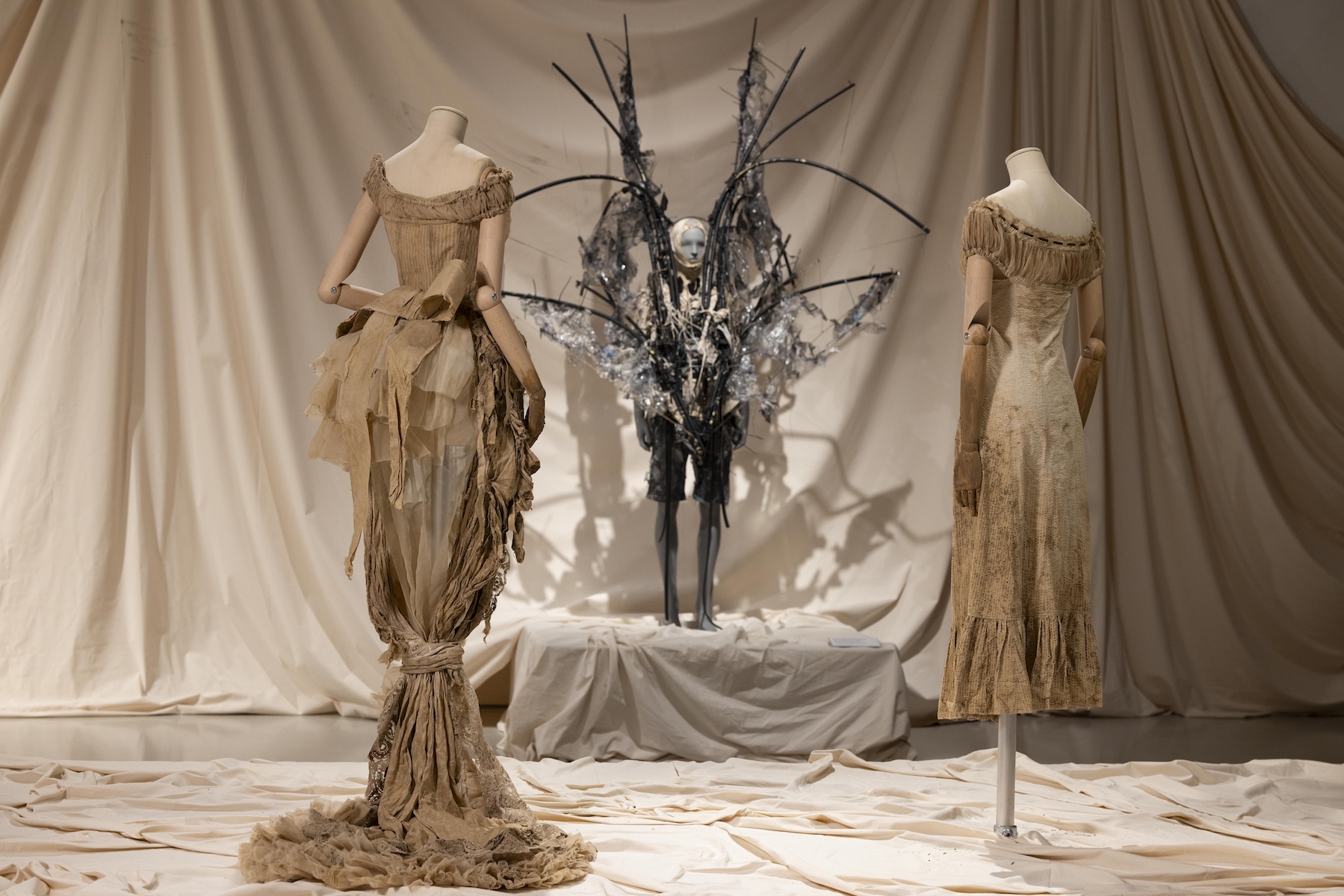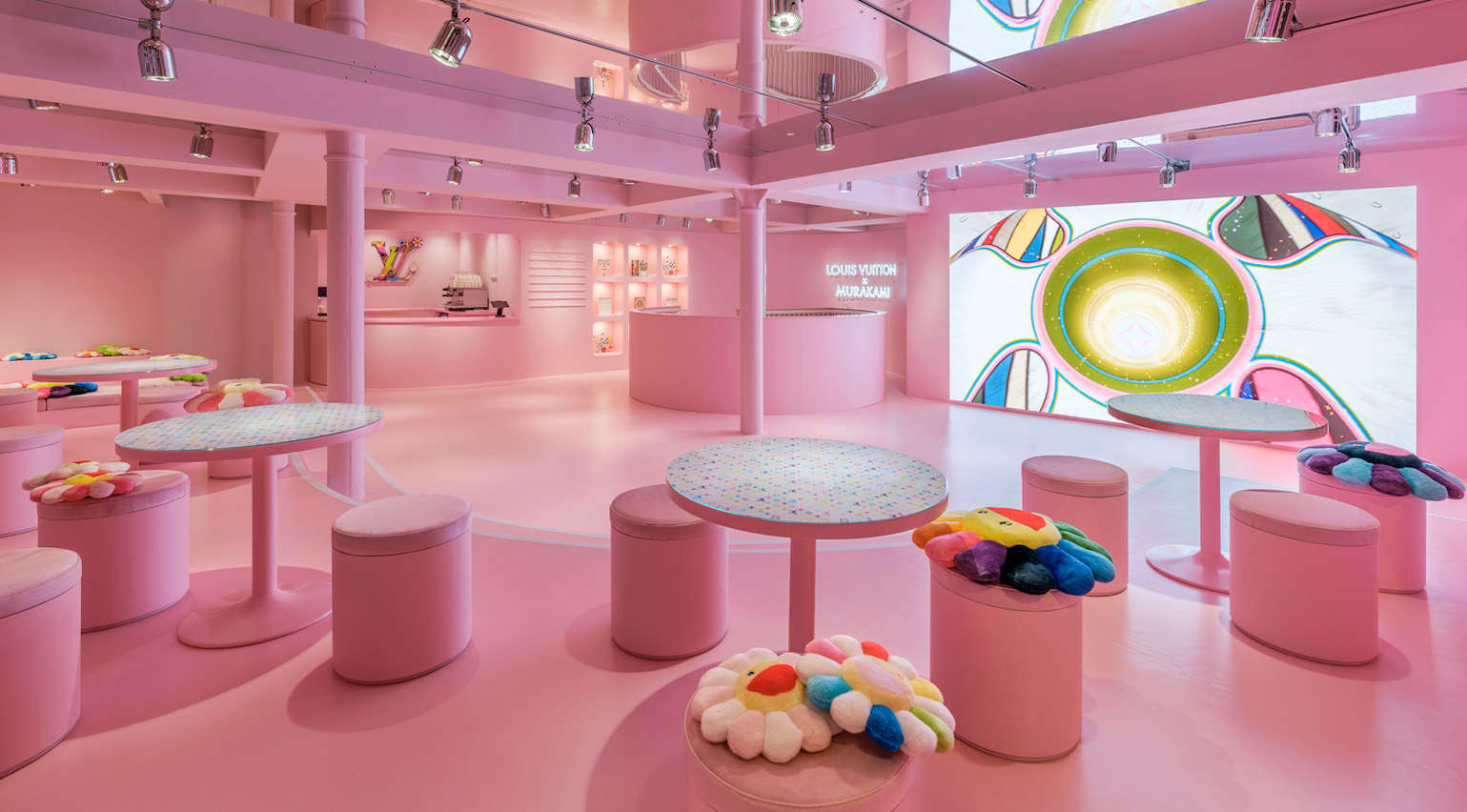
There was a time not so long ago when buyers flocked to London to fill their order books with the city's plethora of digital prints. However, given the natural evolutionary state of things, it seems fair enough to say that we are now in the advanced stages of phase two: an equally enticing embroidery epidemic. Rather than pixels, London's design stars are painting with texture, and none more poetically than Erdem Moralioğlu. Set against a tropical forest of purple-tinged foliage, the designer looked to Victorian biologist and explorer Marianne North as a springboard, transporting fern frond emblems onto his decadent plunge-necked dresses, lined with tiny 19th century button loop holes and tied with delicate spaghetti straps at the shoulder. The procession of tiered, calf-length gowns that followed were born from an undulating line-up of either thickly-worked guipure or the most fragile of fine needle lace - the latter sporting high collars and ruffles much like Victorian undergarments. But it wasn't only needlework on parade: Moralioğlu added raw-edged tweed and print in the form of softly ruffled tea dresses back into the mix, before texture flew in the window with an aviary's worth of feather work in exotic hues of midnight green and blue. His models' long, solitary braids and tattoo-like, flat lace-up Nicholas Kirkwood gladiator sandals, only further served to seal the performance's couture-weight spectacle.

There was a time not so long ago when buyers flocked to London to fill their order books with the city's plethora of digital prints. However, given the natural evolutionary state of things, it seems fair enough to say that we are now in the advanced stages of phase two: an equally enticing embroidery epidemic. Rather than pixels, London's design stars are painting with texture, and none more poetically than Erdem Moralioğlu. Set against a tropical forest of purple-tinged foliage, the designer looked to Victorian biologist and explorer Marianne North as a springboard, transporting fern frond emblems onto his decadent plunge-necked dresses, lined with tiny 19th century button loop holes and tied with delicate spaghetti straps at the shoulder. The procession of tiered, calf-length gowns that followed were born from an undulating line-up of either thickly-worked guipure or the most fragile of fine needle lace - the latter sporting high collars and ruffles much like Victorian undergarments. But it wasn't only needlework on parade: Moralioğlu added raw-edged tweed and print in the form of softly ruffled tea dresses back into the mix, before texture flew in the window with an aviary's worth of feather work in exotic hues of midnight green and blue. His models' long, solitary braids and tattoo-like, flat lace-up Nicholas Kirkwood gladiator sandals, only further served to seal the performance's couture-weight spectacle.

There was a time not so long ago when buyers flocked to London to fill their order books with the city's plethora of digital prints. However, given the natural evolutionary state of things, it seems fair enough to say that we are now in the advanced stages of phase two: an equally enticing embroidery epidemic. Rather than pixels, London's design stars are painting with texture, and none more poetically than Erdem Moralioğlu. Set against a tropical forest of purple-tinged foliage, the designer looked to Victorian biologist and explorer Marianne North as a springboard, transporting fern frond emblems onto his decadent plunge-necked dresses, lined with tiny 19th century button loop holes and tied with delicate spaghetti straps at the shoulder. The procession of tiered, calf-length gowns that followed were born from an undulating line-up of either thickly-worked guipure or the most fragile of fine needle lace - the latter sporting high collars and ruffles much like Victorian undergarments. But it wasn't only needlework on parade: Moralioğlu added raw-edged tweed and print in the form of softly ruffled tea dresses back into the mix, before texture flew in the window with an aviary's worth of feather work in exotic hues of midnight green and blue. His models' long, solitary braids and tattoo-like, flat lace-up Nicholas Kirkwood gladiator sandals, only further served to seal the performance's couture-weight spectacle.

There was a time not so long ago when buyers flocked to London to fill their order books with the city's plethora of digital prints. However, given the natural evolutionary state of things, it seems fair enough to say that we are now in the advanced stages of phase two: an equally enticing embroidery epidemic. Rather than pixels, London's design stars are painting with texture, and none more poetically than Erdem Moralioğlu. Set against a tropical forest of purple-tinged foliage, the designer looked to Victorian biologist and explorer Marianne North as a springboard, transporting fern frond emblems onto his decadent plunge-necked dresses, lined with tiny 19th century button loop holes and tied with delicate spaghetti straps at the shoulder. The procession of tiered, calf-length gowns that followed were born from an undulating line-up of either thickly-worked guipure or the most fragile of fine needle lace - the latter sporting high collars and ruffles much like Victorian undergarments. But it wasn't only needlework on parade: Moralioğlu added raw-edged tweed and print in the form of softly ruffled tea dresses back into the mix, before texture flew in the window with an aviary's worth of feather work in exotic hues of midnight green and blue. His models' long, solitary braids and tattoo-like, flat lace-up Nicholas Kirkwood gladiator sandals, only further served to seal the performance's couture-weight spectacle.

There was a time not so long ago when buyers flocked to London to fill their order books with the city's plethora of digital prints. However, given the natural evolutionary state of things, it seems fair enough to say that we are now in the advanced stages of phase two: an equally enticing embroidery epidemic. Rather than pixels, London's design stars are painting with texture, and none more poetically than Erdem Moralioğlu. Set against a tropical forest of purple-tinged foliage, the designer looked to Victorian biologist and explorer Marianne North as a springboard, transporting fern frond emblems onto his decadent plunge-necked dresses, lined with tiny 19th century button loop holes and tied with delicate spaghetti straps at the shoulder. The procession of tiered, calf-length gowns that followed were born from an undulating line-up of either thickly-worked guipure or the most fragile of fine needle lace - the latter sporting high collars and ruffles much like Victorian undergarments. But it wasn't only needlework on parade: Moralioğlu added raw-edged tweed and print in the form of softly ruffled tea dresses back into the mix, before texture flew in the window with an aviary's worth of feather work in exotic hues of midnight green and blue. His models' long, solitary braids and tattoo-like, flat lace-up Nicholas Kirkwood gladiator sandals, only further served to seal the performance's couture-weight spectacle.
Receive our daily digest of inspiration, escapism and design stories from around the world direct to your inbox.
Jack Moss is the Fashion & Beauty Features Director at Wallpaper*, having joined the team in 2022 as Fashion Features Editor. Previously the digital features editor at AnOther and digital editor at 10 Magazine, he has also contributed to numerous international publications and featured in ‘Dazed: 32 Years Confused: The Covers’, published by Rizzoli. He is particularly interested in the moments when fashion intersects with other creative disciplines – notably art and design – as well as championing a new generation of international talent and reporting from international fashion weeks. Across his career, he has interviewed the fashion industry’s leading figures, including Rick Owens, Pieter Mulier, Jonathan Anderson, Grace Wales Bonner, Christian Lacroix, Kate Moss and Manolo Blahnik.
-
 Apple Music’s new space for radio, live music and events sits in the heart of creative LA
Apple Music’s new space for radio, live music and events sits in the heart of creative LAApple Music’s Rachel Newman and global head of workplace design John De Maio talk about the shaping of the company’s new Los Angeles Studio
-
 David Lynch’s photographs and sculptures are darkly alluring in Berlin
David Lynch’s photographs and sculptures are darkly alluring in BerlinThe late film director’s artistic practice is the focus of a new exhibition at Pace Gallery, Berlin (29 January – 22 March 2026)
-
 Roland and Karimoku expand their range of handcrafted Kiyola digital pianos
Roland and Karimoku expand their range of handcrafted Kiyola digital pianosThe new Roland KF-20 and KF-25 are the latest exquisitely crafted digital pianos from Roland, fusing traditional furniture-making methods with high-tech sound
-
 ‘Architect of glamour’ Antony Price makes a high-voltage return to the runway with 16Arlington
‘Architect of glamour’ Antony Price makes a high-voltage return to the runway with 16ArlingtonFeaturing a runway debut from Lily Allen, the show saw legendary designer Antony Price – best known for outfitting Roxy Music in the 1980s – unite with 16Arlington’s Marco Capaldo on the sensual after-dark collection
-
 ‘Dirty Looks’ at the Barbican explores how fashion designers have found beauty in dirt and decay
‘Dirty Looks’ at the Barbican explores how fashion designers have found beauty in dirt and decayFrom garments buried in River Thames mud to those torn, creased and stained, ‘Dirty Looks’ is a testament to how ‘creativity and new artistic practices can come out of decay’, its curators tell Dal Chodha
-
 Tyler Mitchell’s London show explores the figure of the Black Dandy, ‘imagining what else masculinity could look like’
Tyler Mitchell’s London show explores the figure of the Black Dandy, ‘imagining what else masculinity could look like’Originally part of a visual essay to accompany the Met’s ‘Superfine’ 2025 Costume Institute exhibition, ‘Portrait of the Modern Dandy’ goes on display at Gagosian Burlington Arcade in London this week
-
 Inside Louis Vuitton’s Murakami London pop-up, a colourful cartoon wonderland with one-of-a-kind café
Inside Louis Vuitton’s Murakami London pop-up, a colourful cartoon wonderland with one-of-a-kind caféWallpaper* takes a tour of the Louis Vuitton x Murakami pop-up in London’s Soho, which celebrates the launch of a new ‘re-edition’ accessories collection spanning the greatest hits from the Japanese artist’s long-running collaboration with the house
-
 Get to know Issey Miyake’s innovative A-POC ABLE line as it arrives in the UK
Get to know Issey Miyake’s innovative A-POC ABLE line as it arrives in the UKAs A-POC ABLE Issey Miyake launches in London this week, designer Yoshiyuki Miyamae gives Wallpaper* the lowdown on the experimental Issey Miyake offshoot
-
 Margaret Howell London Fashion Week Women's S/S 2019
Margaret Howell London Fashion Week Women's S/S 2019 -
 London Fashion Week S/S 2023: Ahluwalia to Martine Rose
London Fashion Week S/S 2023: Ahluwalia to Martine RoseThough slimmed-down, London Fashion Week nonetheless provided the moments of creative expression the city is known for – from Ahluwalia’s ode to Africa to Martine Rose’s much-anticipated runway return
-
 Discover these fashion brands at London Craft Week
Discover these fashion brands at London Craft WeekDuring London Craft Week, fashion brands including Smythson, Bally and Serapian are hosting events across the capital